Spanish-style bullfighting
Spanish-style bullfighting is called a corrida de toros (literally a "running of bulls"), tauromaquia or fiesta and is practiced in Spain, where it originates, Mexico, Colombia, Ecuador, Venezuela, Peru, as well as in parts of Southern France and Portugal. In traditional corrida, three toreros, also called matadores or, in French, toréadors, each fight two out of a total of six fighting bulls, each of which is at least four years old and weighs up to about 600 kg or 1,300 lb (with a minimum weight limit of 460 kg or 1,010 lb for the bullrings of the first degree). Bullfighting season in Spain runs from March to October.
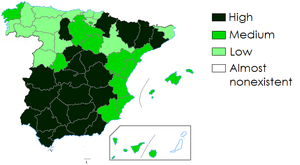
Participants
Each matador has six assistants — two picadores ("lancers") mounted on horseback, three banderilleros ("flagmen"), and a mozo de espada ("sword servant"). Collectively they compose a cuadrilla or team of bullfighters. The crew also includes an ayuda (aide to sword servant) and subalternos (subordinates) including at least two peones (pages, singular peón).
Parts of a bullfight

The modern corrida is highly ritualized, with three distinct parts or tercios, the start of each of which is announced by a trumpet sound. The participants first enter the arena in a parade or paseíllo to salute the presiding dignitary; presidente, accompanied by band music. (The corrida happens to the tune of live-played Pasodobles, many of which were composed to honour famous toreros.) The ritual is a key factor, for example the oldest matador goes to the far left, while the newest will be placed in the middle. If a matador is new to the Plaza, he will do the "paseíllo" without his hat on. Torero costumes are inspired by 18th century Andalusian clothing. Matadores are easily distinguished by their spectacular and quite costly "suit of lights" (traje de luces), custom-made and embroidered with silver or golden thread.
Next, the bull enters the ring to be tested for ferocity by the matador and banderilleros with the magenta and gold capote, or dress cape. Bulls are raised on the open range by specialist breeding estates called ganaderías. The bull enters the arena with a rosette on its back bearing the colours of the estate of its origin.
Stage 1 – Tercio de Varas
In the first stage, the tercio de varas ("part of lances"), the matador observes how the bull charges as capes are thrust by the banderilleros. He also notes vision problems, unusual head movements, or if the bull favors a part of the ring called a querencia, or territory. A bull trying to reach its querencia is often more dangerous than a bull that is attacking the cape directly. The initial attack by the matador is called suerte de capote ("act of the cape"), and there are a number of fundamental "lances" or passes that matadors make; the most common being the verónica, which is the act of a matador letting his cloak trail over the bull's head as it runs past him.

Next, two picadores enter the arena, each armed with a lance or vara. The picadores are mounted on large heavily padded and blindfolded horses. The bull is encouraged to attack the horse which is protected by its padding and appears to treat the attack with stoic patience. The picador stabs a mound of muscle (morrillo) on the bull's neck leading to the animal's first loss of blood. This loss of blood further weakens the bull and makes him ready for the next stage. Padded protection for the horses was mandated relatively recently in history and up to the 1930s the horses were gored and killed by the bull in the ring.
As the picador stabs the top of the bull with the lance, the bull charges and attempts to lift the picador’s horse with its neck muscles. This causes further weakening of the neck. If the picador does his job well, the bull will hold its head and horns lower during the following stages of the fight. This makes him slightly less dangerous while enabling the matador to perform the passes of modern bullfighting.
This stage is a mandatory step in the corrida, and regulations require that the plaza judge ensures a certain number of hits are made before it is completed. In some rings a torero may request more or fewer hits in order to correct any perceived defects.
Stage 2 – Tercio de Banderillas

In the next stage, the tercio de banderillas ("part of banderillas"), the three banderilleros each attempt to plant two barbed sticks (banderillas, literally "little flags" as they are decorated with paper in the local colors) in the bull's shoulders. These further weaken the enormous ridges of neck and shoulder muscle (which set fighting bulls apart from ordinary cattle) through loss of blood, while also frequently spurring the bull into making more ferocious charges. By this point the bull has lost a significant amount of blood and is exhausted. The matador then enters with his cape and sword, tiring the bull further with several runs at the cape.
The placing of the banderillas may be done by the matadors. If the presidente decides that the bull is extraordinarily weak or unwilling to fight, he may order the use of black banderillas, considered to be a disgrace to the breeder.
Stage 3 – Tercio de Muerte
In the final stage, the tercio de muerte ("part of death"), the matador re-enters the ring alone with a small red cape or muleta in one hand and a sword in the other. This cape is stretched with a wooden dowel and, in right-handed passes, the sword as well.
Having dedicated the bull to an individual or the whole audience, the matador uses his cape to attract the bull in a series of passes, both demonstrating his control over it and risking his life by getting especially close to it. The red colour of the cape is a matter of tradition, as bulls are actually color blind: they attack moving objects (the real reason that a red colored cape is used is that any blood stains on it will be less noticeable).[1] There are a number of distinct styles of passes, each with its own name. The fundamental pass with the muleta is the "natural", traditionally meaning a left-handed pass with the muleta without the aid of the sword to prop it up.
The faena ("job") is the entire performance with the muleta, which is usually broken down into a series of "tandas" or "series". A typical tanda might consist of three to five basic passes and then a finishing touch, or "remate", such as a "pase de pecho", or "pase de desprecio". Spectacular passes are celebrated by the audience with shouts of "¡ole!". The faena ends with a final series of passes in which the matador with a muleta attempts to manoeuvre the bull into a position to stab it between the shoulder blades and through the aorta or heart. The entire part of the bullfight with the muleta is called el tercio de muerte ("third of death") suerte de muleta ("act of muleta").
The act of thrusting the sword (estoca or estoque) is called an estocada. A clumsy estocada that fails to give a "quick and clean death" will often raise loud protests from the crowd and may ruin the whole performance. If estocada is not successful, the matador must then perform a descabello and cut the bull's spinal cord with a second sword called verdugo, to kill it instantly and spare the animal pain. Although the matador's final blow is usually fatal, it may take the bull some time to die. A coup de grâce is therefore administered by a peón named a puntillero, using a dagger to further pierce the spinal cord. The matador must kill the bull in 15 minutes after the first muleta pass, at most. After 10 minutes, if the bull is still alive, the presidente will order an aviso, a warning given with a trumpet sound. If a further three minutes elapse, a second aviso will be given; a third and final aviso is given after a further two minutes. The presidente will then give an order to have the bull returned to its pen (corral), or, if local law so requires, to have the bull killed outside the ring. Regardless, it is a dishonor for the failing matador.
The bull's body is dragged out by a team of mules. If the presidente is impressed by the performance of the bull, he orders a tour around the ring to honour the animal. Very rarely, a bull will be allowed to survive a fight as an indulgence granted in recognition of an exceptional performance. The spectators will demand an indulto from the presidente, by waving handkerchiefs before the estocada. The matador will stop and look at the presidente. If he stands still, he will resume his action and kill the bull. But if he has an orange handkerchief hung on his balcony, the matador will imitate the estocada with a banderilla or with the palm of his hand and the bull will be "freed". Such bulls are generally retired from competition and raised as studs, as their experience in the ring makes them extremely dangerous opponents. A fighting bull is never used in the ring twice, because they learn from experience, and the entire strategy of the matador is based on the assumption that the bull has not learned from previous experience. This also invalidates bulls who have been run in their estate by illegal fighters (maletillas), who in earlier times would sneak into an estate by night to practice their skills.
A trofeo (trophy) is the usual indicator of a successful faena. When the records of bullfights are kept, trofeos earned by the matador are always mentioned. If the crowd demands, the matador is allowed to take a lap of victory around the ring. If at least half of the spectators petition the presidente by waving handkerchiefs, the presidente is obliged to award the matador with one ear of the bull. To award the matador with another ear or with two ears and the tail (los máximos trofeos) depends solely on the presidente's appreciation. The matador who won at least two ears is given the permission to be carried on the shoulders of the admirers (salida en hombros). In some areas, such as Seville, three matadors take on two bulls each, and salida en hombros is only available to a matador that wins a total of three trofeos between his two bulls. In general, a matador that faces a bull that is freed is usually awarded los máximos trofeos, although only symbolically; ears or the tail can only be physically cut off of a dead bull.
Hazards
Bullfighting is normally fatal for the bull, and it is dangerous for the matador. Picadors and banderilleros are sometimes gored, but this is not common. They are paid less because their job takes less skill and less courage. The suertes with the capote are risky, but it is the faena, in particular the estocada, that is the most dangerous. A matador of classical (Manolete) style is trained to divert the bull with the muleta but to come close to the right horn as he makes the fatal sword-thrust between the scapulae and through the aorta. At this moment, the danger to the matador is the greatest.
Most matadors have been gored many times. A special type of surgeon has developed, in Spain and elsewhere, to treat cornadas, or horn-wounds. The bullring normally has an infirmary with an operating room, reserved for the immediate treatment of matadors with cornadas.
The bullring has a chapel where a matador can pray before the corrida and where a priest can be found in case an emergency sacrament of extreme unction (also known as Anointing of the Sick or Last Rites) is needed.
Anti-bullfighting movement
Activism against bullfighting has existed in Spain since the beginning of the early nineteenth century, when a group of intellectuals, pertaining to the Generation of '98, embarked on a dual crusade against the popularity of bullfighting and Flamenco music, dismissing them as "non-european" elements of Spanish culture which were to blame for the country's social and economic backwardness. More recently, bullfighting has come under increasing attack from animal rights activists. Perhaps more significantly, separatist and nationalist sentiment in Catalonia has played a key role in the region wide ban of a practice which is strongly associated to Spanish national identity. Galician and Basque nationalism have also expressed abolitionist stances on the basis of identity politics, although in the case of the latter this has been somewhat mooted by the conundrum of bullfighting being at the heart of the San Fermin festival in Pamplona. Animal welfare concerns are perhaps the prime driver of anti-bullfighting outside Spain although rejection of traditionalism and Criollo elitism may also play a role in Latin America, explaining why such activism is so closely associated to leftist or far-leftist positions in Mexico, Ecuador and Colombia.
Animal rights activists claim bullfighting is a cruel or barbarous blood sport, in which the bull suffers severe stress and a slow, torturous death.[2][3][4][5] A number of animal rights or animal welfare activist groups such as Antitauromaquia and StopOurShame undertake anti-bullfighting actions in Spain and other countries.
Others, such as author Alexander Fiske-Harrison who trained as a bullfighter to research for a book on the subject, have argued that there are mitigating circumstances to this: "In terms of animal welfare, the fighting bull lives four to six years whereas the meat cow lives one to two. What is more, it doesn’t just live in the sense of existing, it lives a full and natural life. Those years are spent free, roaming in the dehesa, the lightly wooded natural pastureland which is the residue of the ancient forests of Spain. It is a rural idyll, although with the modern additions of full veterinary care and an absence of predators big enough to threaten evolution’s answer to a main battle tank." Other arguments include those to the effect that the death of animals in slaughterhouses is often much worse than the death in the ring, and that both types of animal die for entertainment since humans do not need to consume meat, eating it instead for taste (bulls enter the food chain after the bullfight).[6]
After a few years of increased pressure on bullfighting by abolitionist movements within Spain, the death of bullfighter Victor Barrio in July 2016, led to hundreds of comments being posted on various social media expressing joy at his death and openly mocking his family and widow. This has led to a significant backlash within Spain against anti-bullfighting activism and criminal investigations are ongoing against those involved. Within a few days of Barrio's death, over 200,000 signatures had been collecting demanding action be taken against one such activist.[7]
Special events
- Mano-a-mano corridas are bullfights where two matadores fight three bulls each in competition. Often, they are rivals; sometimes, even enemies.
- Encerronas are bullfights where a matador will fight six bulls
- Novilladas are bullfights where younger bulls of two to four years of age (novillos) and apprentice toreros (novilleros) are involved. Novilladas with novillos younger than three years are held without picadores. For novillos aged three, a shorter vara is used.
- Festivales are bullfights where toreros, novilleros, and amateurs alike can attend. They are held for charity purposes. The costume worn at festivales is not the ornate traje de luces, but the more staid, humble traje corto . The bulls used for a festivale often have their horn-tips shaved or truncated, a practice that is deprecated by some writers. Some people think these bulls are safer, but this is not a reliable belief: the bull will not hit his target accurately, but the force of the blow will be unreduced. The wound may be more of a bruise than a sharp cut, but the surgeon will have a difficult time repairing it.
- Corridas Goyescas are special events that intend to reflect the visuality of bullfights represented in the works of Francisco de Goya. This type of bullfights was originally introduced at Ronda in 1954.
Other lesser spectacles
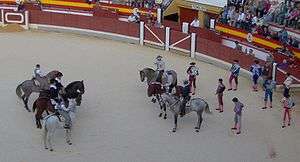
Professional
- The rejoneo or corrida de rejones: A rejoneador (lancer) on horseback tries to stab the bull with javelins called rejones de castigo in the first stage and banderillas in the second. In the final stage, the rejoneador kills the bull with a rejón de muerte (lance of death). On some occasions, the rejoneador will kill the bull on foot in the traditional way with muleta and estoca.
- The recortes: A bullfighter dodges around the bull and does not use a cape or sword.[8] Bulls are not killed during this type of bullfight. Most specialists in this form of bullfighting come from Aragon.
- Comedy spectacles, such as El bombero torero y los enanitos toreros ("The bullfighting fireman and the bullfighting dwarves").
Amateur
- The encierro: A "running" of the bulls through the streets. Customarily, runners run before the bulls to guide them from the pen to the plaza, where the bulls will await the afternoon's bullfight. The most famous is that of Pamplona in July, although encierros exist in towns throughout Spain. It is a dangerous activity, and care should be taken by those who wish to participate. In Segorbe, bulls are herded to the bullring by riders on horseback, an event called Entrada de toros y caballos, which is a tourist attraction.
- The bous al carrer (bulls at the street in Catalan) commonly found in Comunidad Valenciana and some places in Catalonia. The main difference from a encierro is that the bulls aren't directed to any bullring
- A Mediterranean variation, called bous a la mar (bulls at the sea), takes place on a dock. The youths jump into the water when the cow has cornered them. One place famous for this festivity is Dénia
- Another variation is the toro embolado ("fire bull"). This fiesta takes place at midnight. Balls of flammable material or actual fireworks are placed on the horns. The bull is set free on the street where young men dodge and run away from the charging animal
- The Toro de la Vega: This takes place in September at Tordesillas. A bull is run through an open area and over a bridge across the Duero River. There a crowd (on foot and on horse) tries to kill the bull with spears and lances before it reaches the other side.[9] Considered as an espectáculo tradicional (traditional spectacle) by the government of Castilla y León.
- The vaquillas (sokamuturra in Basque): A young cow of fighting stock is freed in a small ring (often built for the period of the festival and then dismantled) among local youths who tease her. The cow may have a dangling rope for recovery purposes.
Gallery
The phases of the Spanish-style bullfighting
-

Tercio de varas: Suerte de capote.
-
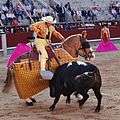
Tercio de varas: El Picador on a caparisoned and blindfolded horse pierces the back of the bull with a spear.
-
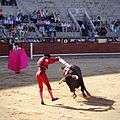
Tercio de banderillas: El Banderillero stabs the banderillas on the back of the bull.
-
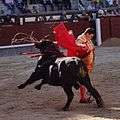
Tercio de muerte: Suerte de muleta.
-
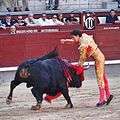
Tercio de muerte: El Matador pierces the heart of the bull with his sword.
-
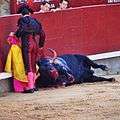
Tercio de muerte: The bull fatally hit falls to the ground.
-

The dead bull is dragged away from the arena.
See also
References
- ↑ http://www.livescience.com/33700-bulls-charge-red.html
- ↑ What is bullfighting?
|first1=missing|last1=in Authors list (help) - ↑ Running of the Bulls Factsheet
|first1=missing|last1=in Authors list (help) - ↑ ICABS calls on Vodafone to drop bullfighting from ad
|first1=missing|last1=in Authors list (help) - ↑ The suffering of bullfighting bulls
|first1=missing|last1=in Authors list (help) - ↑ Fiske-Harrison, Alexander, "Perhaps bullfighting is not a moral wrong: My talk at the Edinburgh International Book Festival," The Last Arena: In Search Of The Spanish Bullfight blog. 25 July 2012
- ↑ http://zoquejo.com/not/27817/mas-de-217-000-firmas-piden-la-inhabilitacion-del-profesor-que-insulto-al-torero-fallecido-victor-barrio
- ↑ "a man jumps over a bull during a recortadores bullfight in Algeciras, Spain". The Sydney Morning Herald.
- ↑ Douglass, Carrie B. (1997). Bulls, Bullfighting, And Spanish Identities. ISBN 0-8165-1651-0.